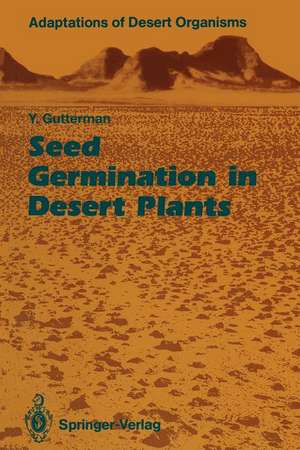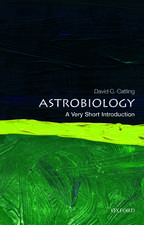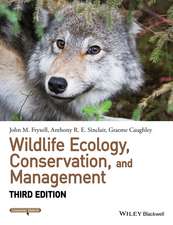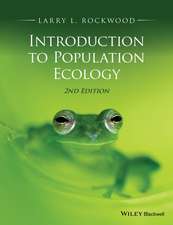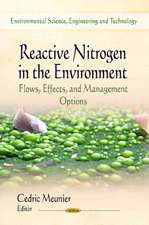Seed Germination in Desert Plants: Adaptations of Desert Organisms
Autor Yitzchak Guttermanen Limba Engleză Paperback – 13 dec 2011
Din seria Adaptations of Desert Organisms
- 18%
 Preț: 954.14 lei
Preț: 954.14 lei - 18%
 Preț: 948.29 lei
Preț: 948.29 lei - 18%
 Preț: 945.92 lei
Preț: 945.92 lei - 18%
 Preț: 947.35 lei
Preț: 947.35 lei - 18%
 Preț: 1384.44 lei
Preț: 1384.44 lei - 18%
 Preț: 946.10 lei
Preț: 946.10 lei - 18%
 Preț: 1212.68 lei
Preț: 1212.68 lei - 18%
 Preț: 953.82 lei
Preț: 953.82 lei - 15%
 Preț: 632.70 lei
Preț: 632.70 lei - 15%
 Preț: 635.31 lei
Preț: 635.31 lei - 15%
 Preț: 639.73 lei
Preț: 639.73 lei -
 Preț: 382.57 lei
Preț: 382.57 lei - 15%
 Preț: 636.80 lei
Preț: 636.80 lei - 15%
 Preț: 640.24 lei
Preț: 640.24 lei - 15%
 Preț: 641.03 lei
Preț: 641.03 lei - 15%
 Preț: 636.45 lei
Preț: 636.45 lei - 15%
 Preț: 632.37 lei
Preț: 632.37 lei - 15%
 Preț: 637.28 lei
Preț: 637.28 lei -
 Preț: 378.92 lei
Preț: 378.92 lei - 15%
 Preț: 633.53 lei
Preț: 633.53 lei - 15%
 Preț: 693.71 lei
Preț: 693.71 lei - 15%
 Preț: 636.45 lei
Preț: 636.45 lei - 15%
 Preț: 641.53 lei
Preț: 641.53 lei -
 Preț: 388.34 lei
Preț: 388.34 lei -
 Preț: 395.63 lei
Preț: 395.63 lei
Preț: 639.25 lei
Preț vechi: 752.06 lei
-15% Nou
Puncte Express: 959
Preț estimativ în valută:
122.33€ • 132.84$ • 102.76£
122.33€ • 132.84$ • 102.76£
Carte tipărită la comandă
Livrare economică 22 aprilie-06 mai
Preluare comenzi: 021 569.72.76
Specificații
ISBN-13: 9783642757006
ISBN-10: 3642757006
Pagini: 272
Ilustrații: XIII, 253 p.
Dimensiuni: 155 x 235 x 14 mm
Greutate: 0.39 kg
Ediția:Softcover reprint of the original 1st ed. 1993
Editura: Springer Berlin, Heidelberg
Colecția Springer
Seria Adaptations of Desert Organisms
Locul publicării:Berlin, Heidelberg, Germany
ISBN-10: 3642757006
Pagini: 272
Ilustrații: XIII, 253 p.
Dimensiuni: 155 x 235 x 14 mm
Greutate: 0.39 kg
Ediția:Softcover reprint of the original 1st ed. 1993
Editura: Springer Berlin, Heidelberg
Colecția Springer
Seria Adaptations of Desert Organisms
Locul publicării:Berlin, Heidelberg, Germany
Public țintă
ResearchCuprins
1 The Negev Desert of Israel and Other Hot Deserts of the World: Classification According to Quantities, Distribution and Seasons of Rain. Their Influences on the Germination of Desert Plants.- 1.1 Classification of Deserts of Semi-Arid and Arid Zones and the Season of Rain.- 1.2 Abiotic Environmental Factors of the Negev Desert.- 1.3 Some Biotic Factors Affecting the Vegetation of the Negev Desert.- 1.4 Autecological Adaptations, Life Forms and the Annual Cycle of Desert Angiospermae.- 2 Phenotypic Effects on Seeds During Development.- 2.1 Introduction.- 2.2 Position Effects.- 2.3 Age Effects.- 2.4 Environmental Effects.- 2.5 Polymorphic Seeds and Germination.- 2.6 Conclusions.- 3 Seed Dispersal and Seed Predation of Plants Species in the Negev Desert.- 3.1 The Annual Cycle of Seed Maturation and Dispersal of Some of the Common Species in the Negev Desert Highlands.- 3.2 Seed Maturation and Dispersal in Summer.- 3.3 Seed Maturation in Summer and Dispersal by Rain in Winter.- 3.4 Seed Maturation in Summer and Germination in Situ (Atelechory) in Winter.- 3.5 Seeds That Mature and Are Dispersed in Winter.- 3.6 Heterocarpy and Species Survival.- 3.7 Conclusions.- 4 Storage Conditions Affecting the Germinability of Seeds in the Seed Bank.- 4.1 Introduction.- 4.2 Seed Internal and Environmental Factors During Storage Affecting Germination.- 4.3 Conclusions.- 5 Environmental Factors During Seed Imbibition Affecting Germination.- 5.1 Introduction.- 5.3 The Period of Wetting for Germination.- 5.4 Temperature.- 5.5 Light and Germination.- 5.6 Annual Rhythm Regulating Seed Germination.- 5.7 Mass Germination and Seedling Emergence from Below the Soil Crust.- 5.8 Conclusion.- 6 Germination, the Survival of Seedlings and Competition.- 6.1 Introduction.- 6.2 ‘Opportunistic’ or‘Cautious’ Strategy. Low or High Chance of Seedling Survival.- 6.3 Depressions and Porcupine Diggings as Favourable Micro-Habitats in the Desert.- 6.4 Drought Tolerance and the Survival of Seedlings.- 6.5 Mass Germination and Age Groups Replace Dead Plants.- 6.6 Conclusion.- 7 Conclusion.- References.- Latin Name Index.
Recenzii
"This work represents a valuable addition to the botanical literature and can be regarded as the first comprehensive publication on the subject." The Quarterly Review of Biology
